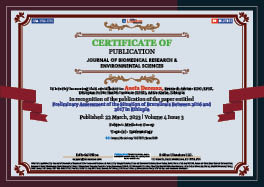Medicine Group . 2023 March 22;4(3):472-473. doi: 10.37871/jbres1699.
Preliminary Assessment of the Situation of Brucellosis Between 2016 and 2017 in Ethiopia
Asefa Deressa*
Background
Brucellosis is a zoonotic disease affecting humans, domesticated livestock and wildlife and is considered one of the most common and economically important zoonoses globally. Megersa B, et al. [1] Indicated that human infection occurs from exposure to infected animals or contaminated animal products such as unpasteurized milk or dairy products. In humans, brucellosis is a debilitating and disabling disease, often misdiagnosed due to the resemblance with other acute febrile illnesses. According to Haileselassie M, et al. [2], in domestic livestock, the disease is primarily caused by Brucella abortus and Brucella melitensis in cattle, and small ruminants, respectively, and is associated with production losses (i.e., abortion, decreased milk production, and infertility).
Objective
With this background, the objective of this assessment was to estimate brucellosis prevalence in households who own livestock, identify risk factors for Brucella infection in humans and livestock in three areas representing the rural livestock production systems in Ethiopia. In each household, we collected information on risk factors and household demographics in addition to animal/herd information. Serum collected from humans, cattle, and small ruminants was tested for Brucella antibodies using ELISA.
Materials and Methods
Based on the outlined selection criteria selection of sites from the three main ruminant livestock production and management systems of smallholders in Ethiopia: pastoral, agro-pastoral, and mixed crop–livestock systems.
The sampling formula was used in order to allow sufficient sample size to produce reliable estimates in each area and account for unknown variability. It was estimated that a total sample size of approximately 3,417 people, 3,417 cattle, and 3,417 sheep and goats were needed for this study. This sample size was based on an estimated prevalence of 6% in both humans and livestock. We also assumed a 2% margin of error, a design effect of 2, and a response rate of 95% among all tested [3].
Result
A total of 1,100 households were sampled with 901 households having complete data, which included household-matched human/animal surveys, ELISA results, and a household survey. A total of 4,621 animals and 2,860 people with ELISA and survey results were included in our study. Our study shows a variable brucellosis prevalence in both humans and animals; with the selected areas of South Ethiopia site having the highest prevalence of brucellosis in both humans and animals followed by selected area in Amhara and Central Oromia. Overall, brucellosis seroprevalence in cattle was 5.6% (n = 140). When stratified by site, brucellosis seroprevalence was 7% (n = 60), 3% (n = 32) and 9% (n = 48) in Amhara, Central Oromia and South Ethiopia, respectively.
Discussion
The prevalence of Brucella antibodies in both humans and livestock investigated and evaluated risk factors that could potentially be driving the disease spread in the rural livestock system in Ethiopia was discussed by Mekonnen G [4]. To date, this study has one of the largest sample sizes of humans and livestock in Ethiopia from the same household and compared three different areas of the country. The reason for regional differences is likely multifactorial with underlying livestock brucellosis burden, livestock system, human behavior, and cultural practices playing an important role. Humans almost always acquire brucellosis by being in contact with infected animals; via direct contact with infected animal tissues or fluids or by consumption of raw milk and milk products [5]. Thus, the underlying livestock brucellosis burden will have an impact on human brucellosis burden
Conclusion
Because behaviors, disease prevalence, and livestock system are quite different, there is not a “one size fits all” disease control strategy to be used throughout the country. As a result, each livestock system should be considered and addressed separately during the development and implementation of the National Brucellosis Control Program. A One health Approach to address the brucellosis situation in Ethiopia should be used to ensure the sustainability and success of the interventions.
References
- Megersa B, Biffa D, Abunna F, Regassa A, Godfroid J, Skjerve E. Seroepidemiological study of livestock brucellosis in a pastoral region. Epidemiol Infect. 2012 May;140(5):887-96. doi: 10.1017/S0950268811001178. Epub 2011 Jul 27. PMID: 21791149.
- Haileselassie M, Kalayou S, Kyule M, Asfaha M, Belihu K. Effect of Brucella infection on reproduction conditions of female breeding cattle and its public health significance in Western tigray, northern ethiopia. Vet Med Int. 2011;2011:354943. doi: 10.4061/2011/354943. Epub 2011 Jul 21. PMID: 21822466; PMCID: PMC3142704.
- The 2007 Population and Housing (CSA) Census of Ethiopia. Statistical Summary Report at National Level. In: Central Statistical Agency, editor. Addis Ababa; 2008.
- Mekonnen G. Sero-epidemiological investigation of bovine brucellosis in northwestern Ethiopia. Bahir Dar, Ethiopia: University of Bahir Dar. 2001.
- Regassa G, Mekonnen D, Yamuah L, Tilahun H, Guta T, Gebreyohannes A, et al. Human Brucellosis in Traditional Pastoral Communities in Ethiopia. International Journal of Tropical Medicine. 2009;4(2):59-64.
Content Alerts
SignUp to our
Content alerts.
 This work is licensed under a Creative Commons Attribution 4.0 International License.
This work is licensed under a Creative Commons Attribution 4.0 International License.








